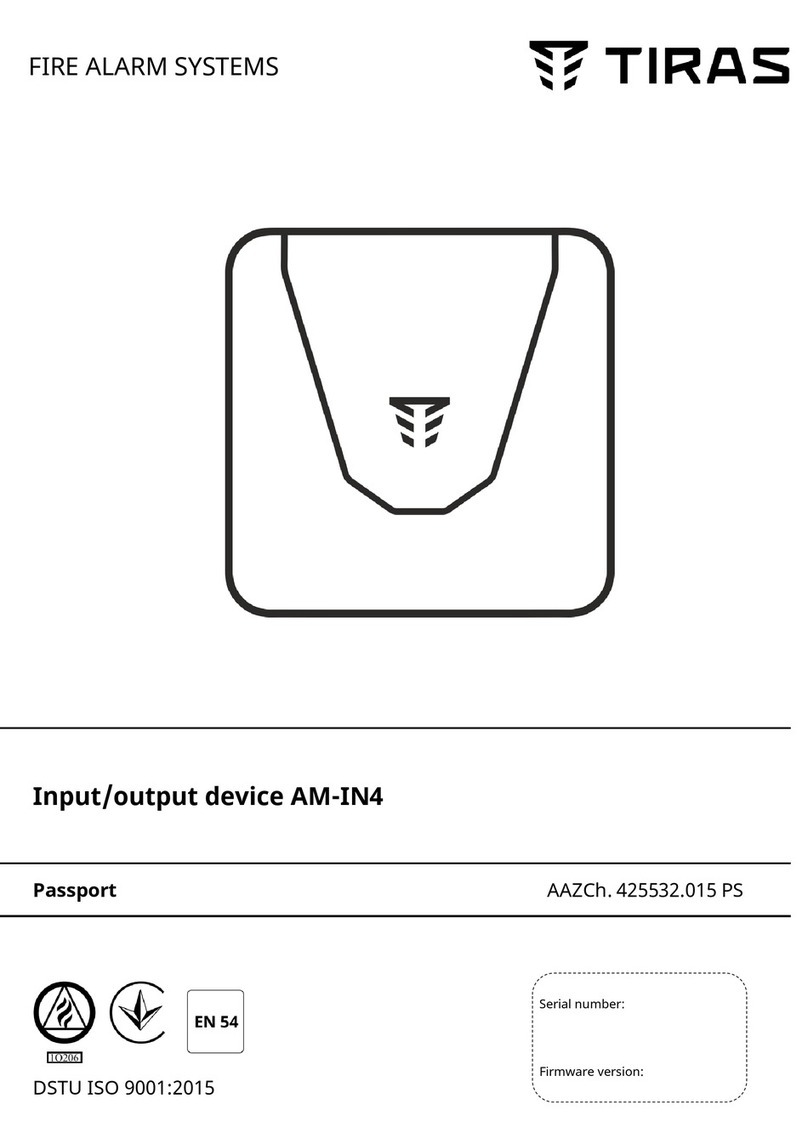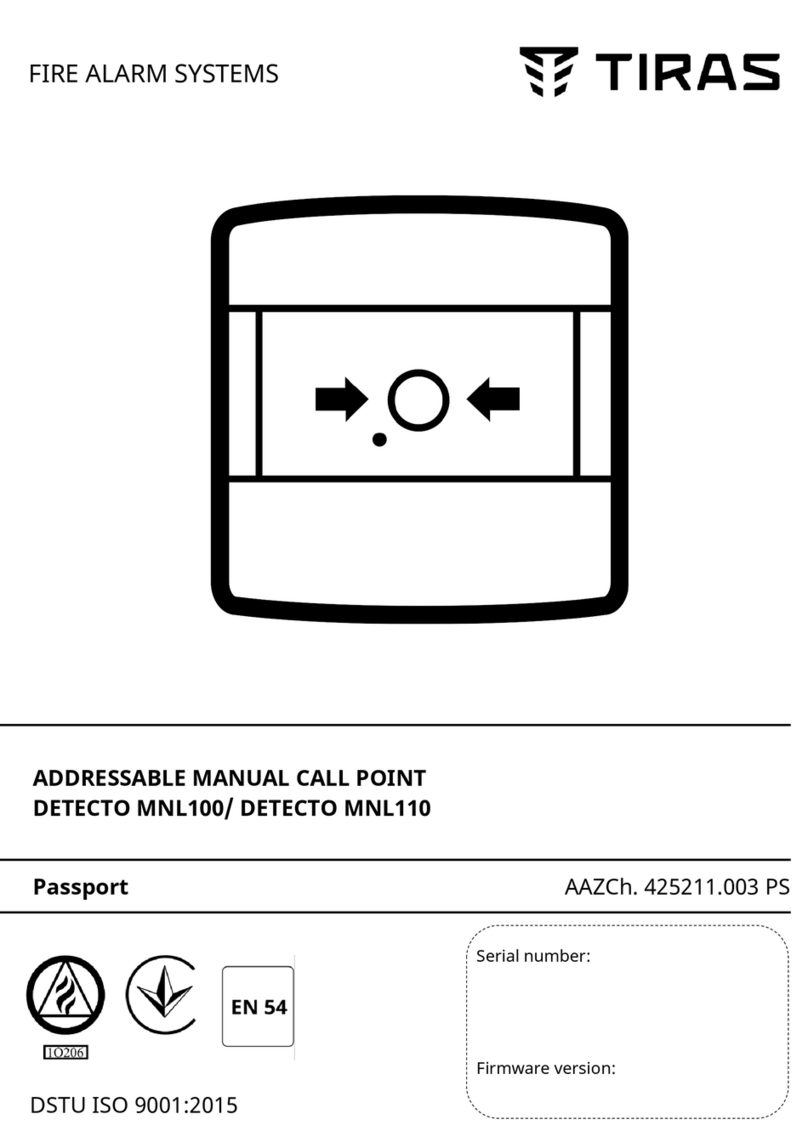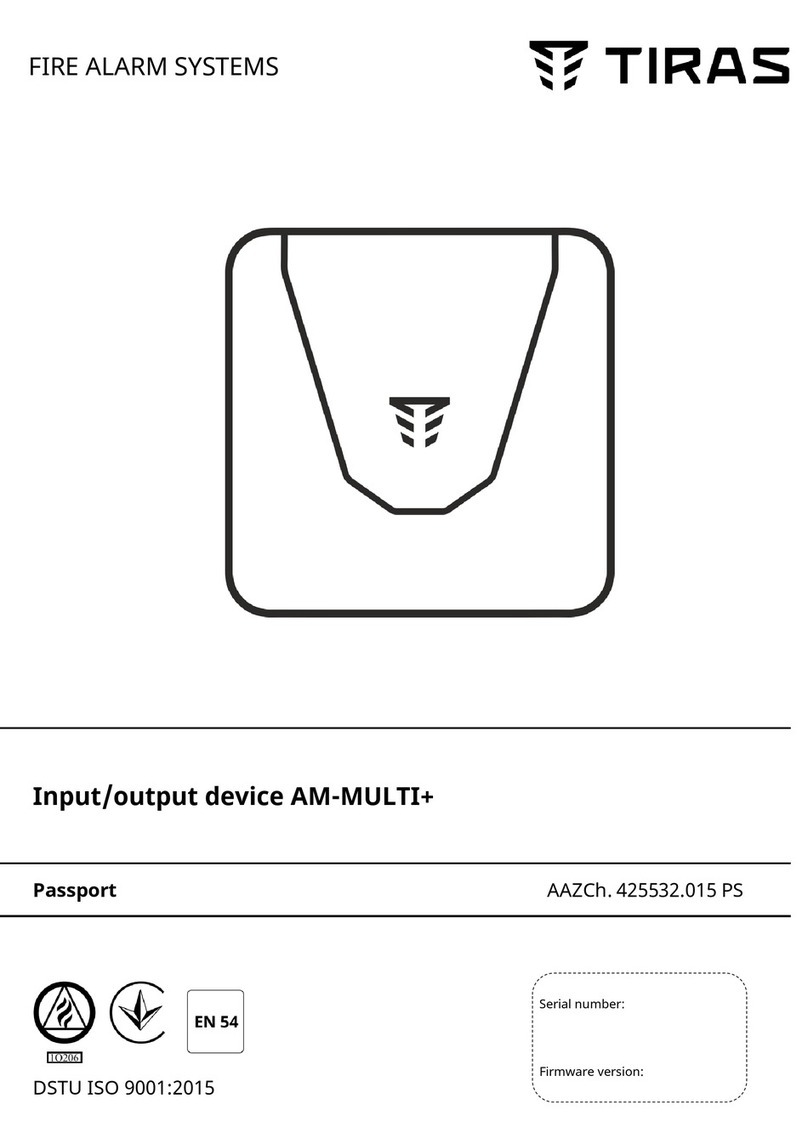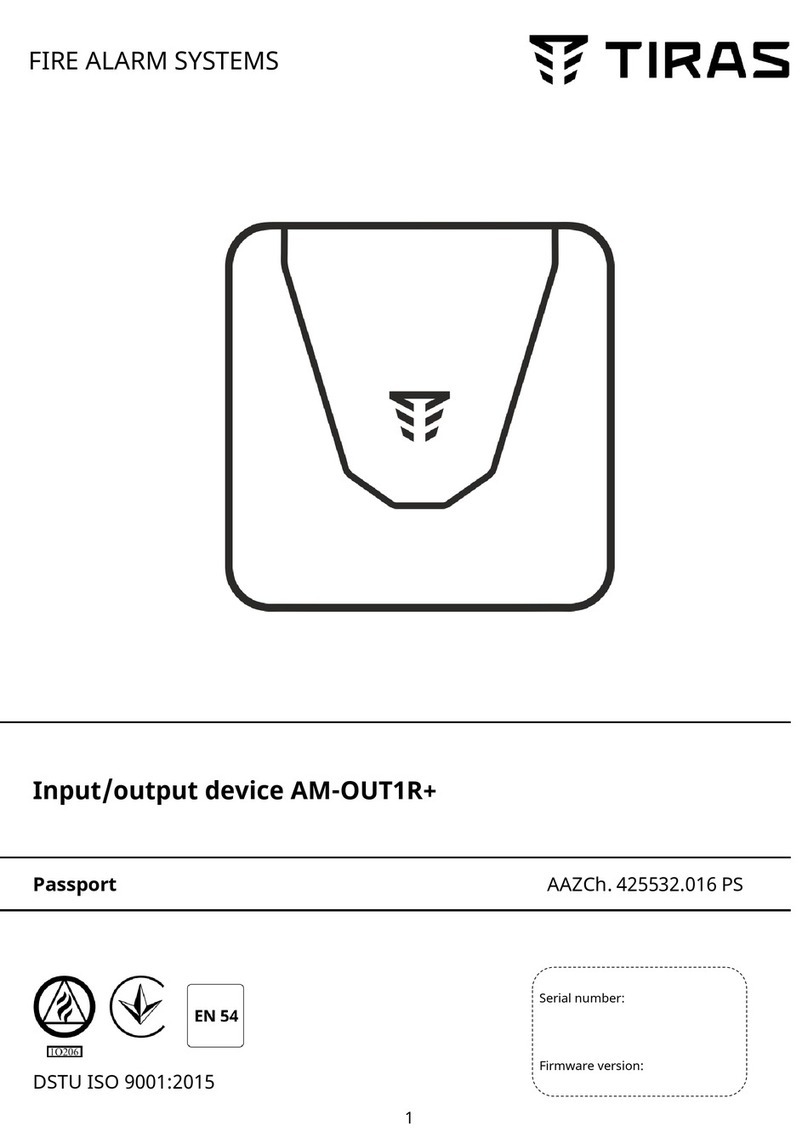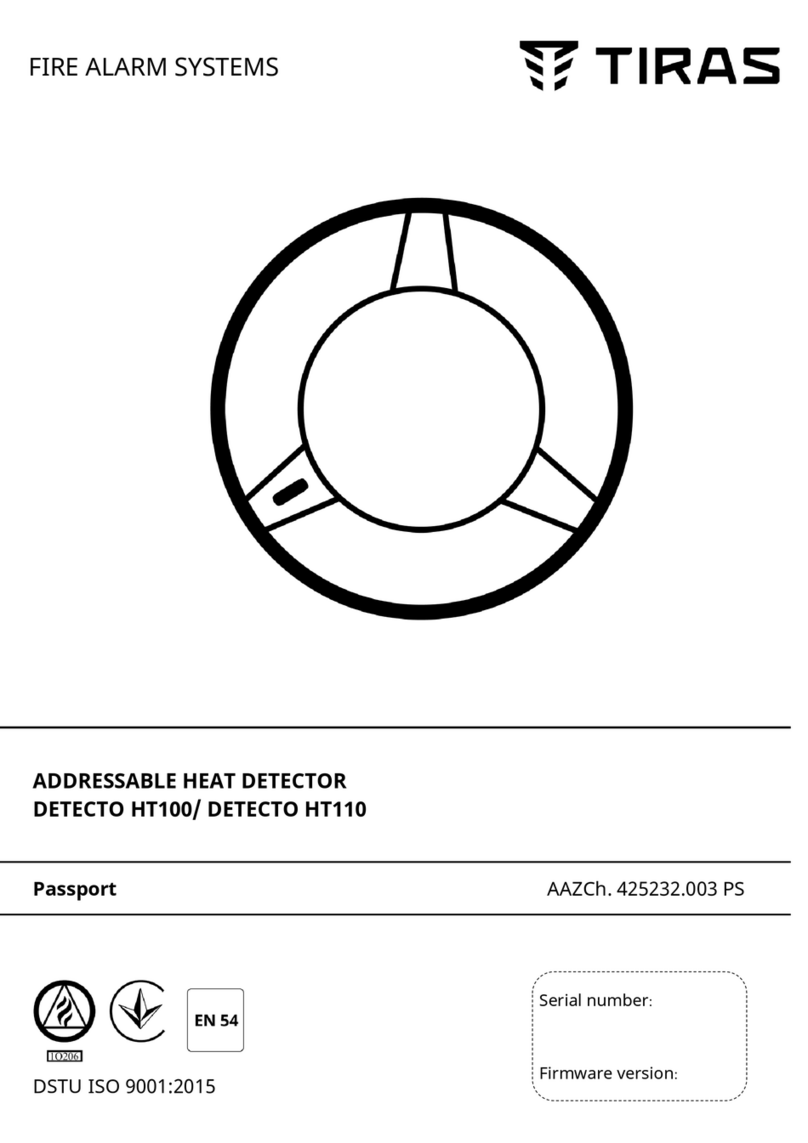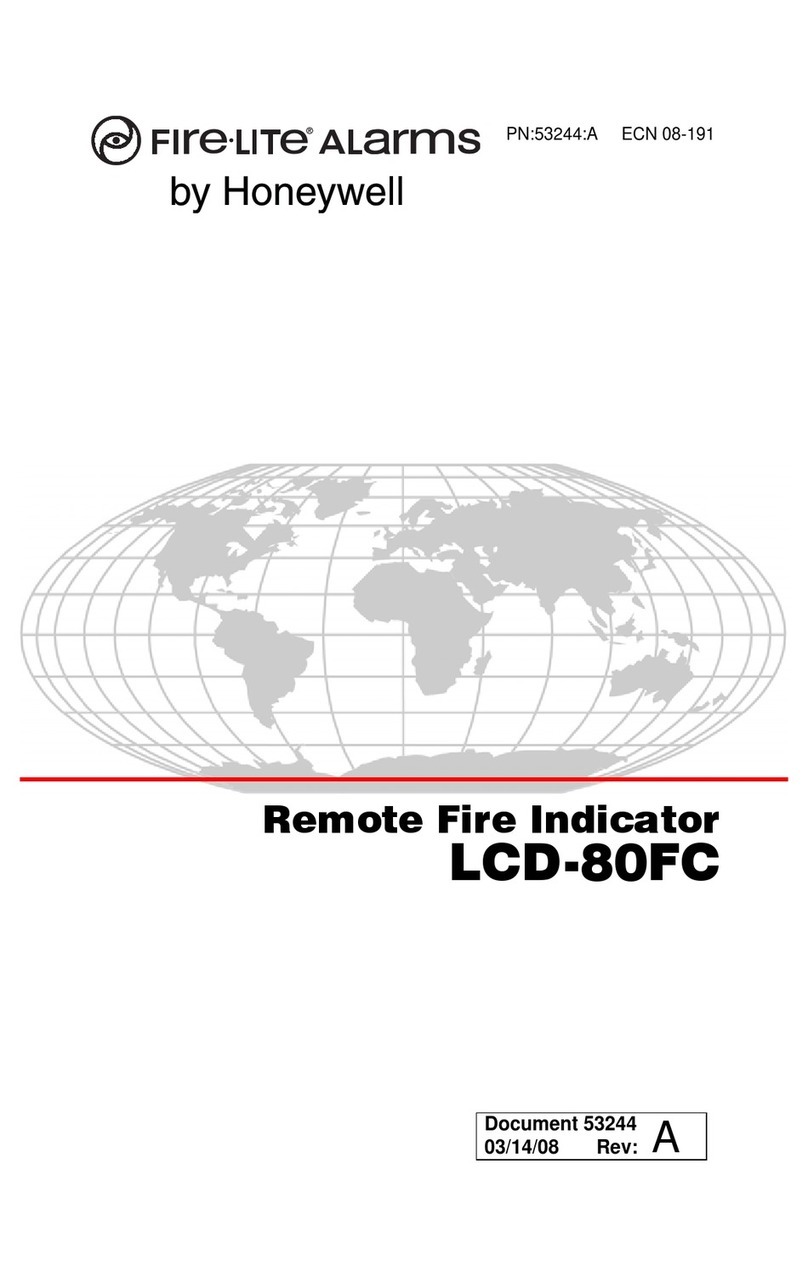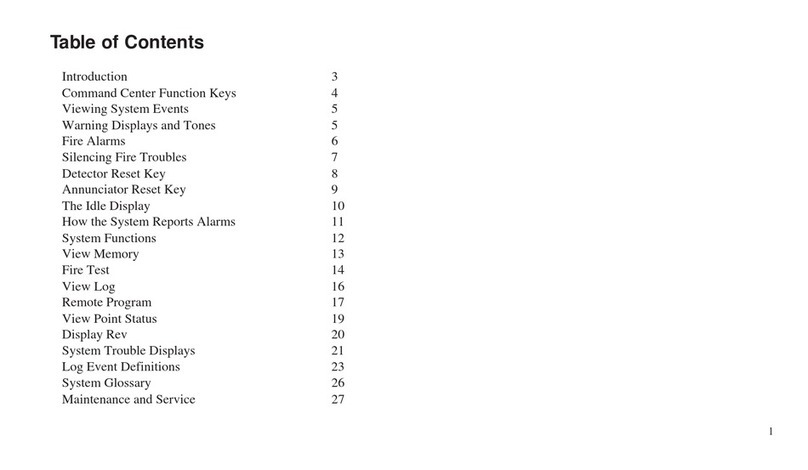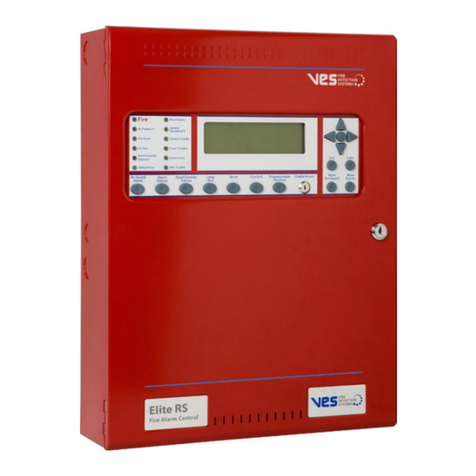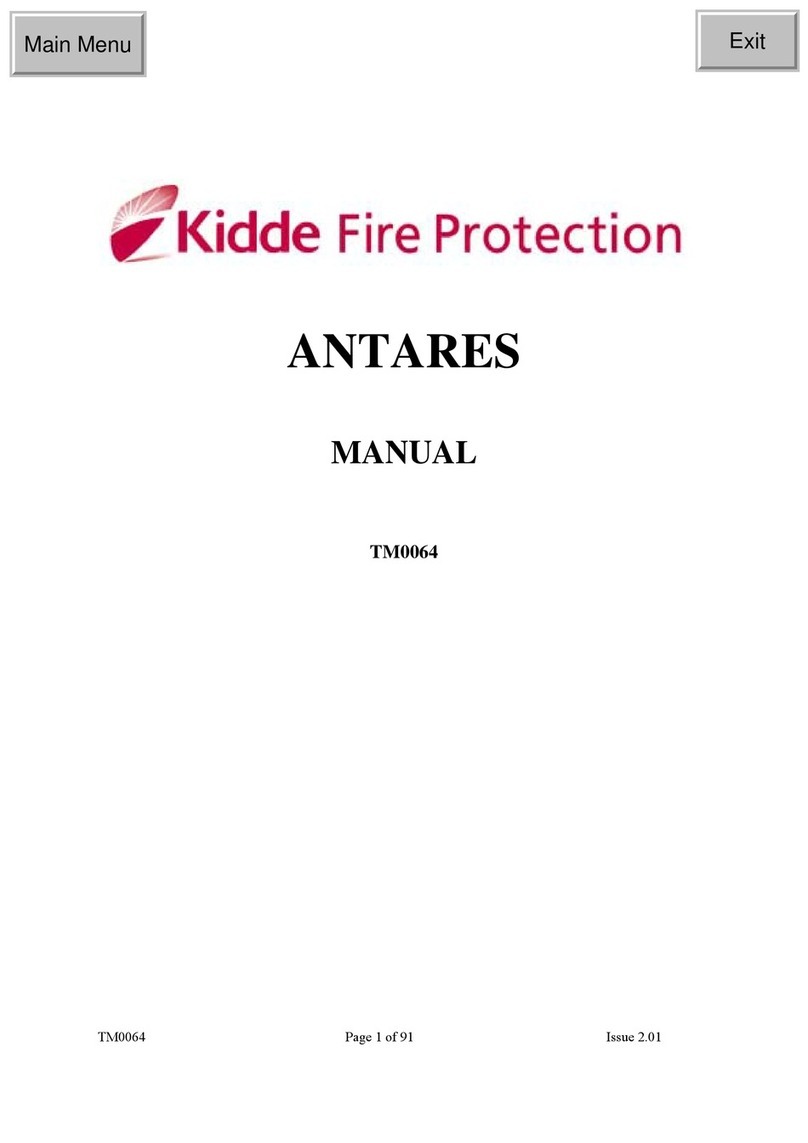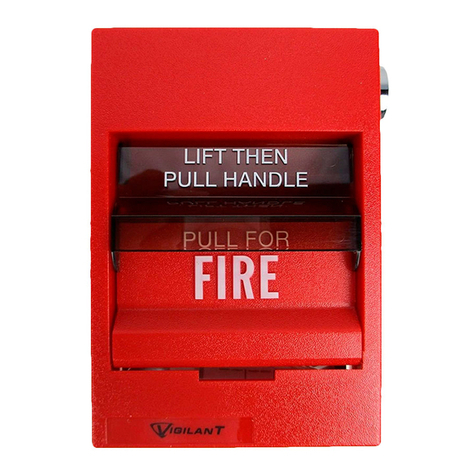Tiras PRIME 8L User manual

FIRE ALARM SYSTEMS
FACP «TIRAS PRIME 8L»
User Manual
ААZCh.425521.014 UM
DSTU ISO 9001:2015
Serial number:
FW version: PRIME8L_1

2
Thank you for choosing
equipment produced by Tiras-12 Ltd.
Before using the product,
please refer to this document *
and save it to receive
the necessary information in the future.
For more information
and loading the documentation
use the following links:
www.tiras.ua
DOCUMENTS:
User manual
Installation
manual
APPLICATIONS:
tLoader
(Windows)
tLoader
(Android)
* - this manual is intended for built-in firmware PRIME8L_1

3
Fire Alarm Control Panel «Tiras PRIME 8L» complies with essential requirements of the
following European Union Regulations and Directives:
- Construction Products Regulation (EU) No 305/2011;
- Low Voltage Directive 2014/35/EU;
- EMC Directive 2014/30/EU;
- Directive 2011/65/EU (RoHS).
Fire Alarm Control Panel «Tiras PRIME 8L» complies with requirements of the following
European Union standards:
- EN 54-2:1997+AC:1999+A1:2006;
- EN 54-4:1997+AC:1999+ A1:2002+A2:2006
The EC Certificate of Constancy of Performance No 1438-CPR-0647 was issued by the
CNBOP-PIB Notified Body
1438
«Tiras-12» LTD
2nd Lane Khmelnytske Shosse, 8, Vinnytsia, Ukraine, 21021
Fire Alarm Control Panel «Tiras PRIME 8L»
EN 54-2:1997+AC:1999+A1:2006;
EN 54-4:1997+AC:1999+ A1:2002+A2:2006
Main provided functions:
−Output to fire alarm devices
−Alarm transmission routing equipment
−Fault warning routing equipment
−Total loss of the power supply
−Dependencies on more than one alarm signal
−Delay to outputs
Information about additional functions, inputs and outputs specified in this manual.
The Quality Management System of the «Tiras-12» LTD is certified according to DSTU ISO
9001:2015. Certificate № UA 8О050.008QMS-18 with effect from 27.04.2018 to 26.04.2021.
The full text of the declarations of conformity to technical regulations and certificates is
available on the website at the following address: www.tiras.ua.

4
Contents
1 Abbreviations ...................................................................................................................................5
2 Terms and definitions .....................................................................................................................5
3 Function and structure of FACP .....................................................................................................5
4 General information ........................................................................................................................6
5 Specifications....................................................................................................................................6
6 Safety requirements........................................................................................................................8
7 Structure and operation..................................................................................................................8
7.1 Terminals for connection of primary module..................................................................11
7.2 Operation .............................................................................................................................11
7.2.1 Indication.....................................................................................................................11
7.2.2 Controls .......................................................................................................................12
7.2.3 FACP operation modes (Conditions) ........................................................................ 13
7.2.4 Access levels................................................................................................................14
7.2.5 Level 1 (View)............................................................................................................... 14
7.2.6 Level 2 (Control).......................................................................................................... 14
7.2.7 Level 3 (Configuration)............................................................................................... 19
7.2.8 Level 4 (Service) ..........................................................................................................19
8 Maintenance...................................................................................................................................19
8.1 General .................................................................................................................................19
8.2 Replacing battery of real time clock..................................................................................20
8.3 Battery fuse..........................................................................................................................20
8.4 Main power source fuse ..................................................................................................... 20
9 Package contents...........................................................................................................................20
10 Manufacturer declarations .............................................................................................................21
11 Certificate of acceptance.................................................................................................................21
12 Certificate of re-acceptance ............................................................................................................21
13 Operation and storage conditions..................................................................................................21
14 Warranty obligations ......................................................................................................................21
15 Limitation of liability........................................................................................................................21
16 Repair .............................................................................................................................................22
17 Disposal..........................................................................................................................................22
Appendix A. Wiring diagram............................................................................................................23

5
This manual contains a description, operating rules and passport data of the fire alarm
control panel (further –FACP) –Tiras PRIME 8L.
FACP meets the mandatory requirements of EN54-2, as well as the following optional ones:
outputs to fire alarm devices, output to alarm transmission routing equipment, output to fault
warning routing equipment, delays of outputs, dependencies in zones. FACP contains a built-in
power supply unit (further - PS), meeting the requirements of EN54-4.
In order to avoid possible errors in operation and damage of the equipment, it is
necessary to read carefully this manual and installation manual (AAZCH.425521.014 IM) before
using control panel.
1 Abbreviations
The following abbreviations are used in this document:
FACP
–fire alarm control panel;
FARS
–fire alarm receiving station;
PC
–personal computer;
ATS
–alarm transmission system;
SC
–short circuit;
PS
–power supply;
IM
–Installation Manual for FACP (www.tiras.ua)
2 Terms and definitions
Fire Alarm System (FAS) –group of components installed in the system of the definite
configuration, which is capable of detecting and indicating fire and of signaling to take the
appropriate measures;
Detector –FAS component containing at least one sensor that permanently or
periodically monitors at least one physical and / or chemical phenomenon associated with fire
at a low interval of time and produces at least one corresponding signal to FACP;
Fire Alarm Device (Siren, Sounder) –sound or light and sound device designed to alert
people on the need to evacuate from areas with a fire detected;
Zone –certain part of protected premises, in which one or more components are installed
and for which a general status indication is provided;
Verification (Dependence) –software function, used to confirm the triggering of detector
by checking that it is re-triggered by automatic reset or expecting the triggering of two
detectors in one or more detection circuits or zones;
Communicator –device, intended for transmitting messages to FARS;
Expansion Module –device, designed to increase the number of zones and (or) outputs.
3 Function and structure of FACP
FACP is designed to:
•Control the state of fire detectors;
•Control the sounders;
•Control the external devices;
•Control the state of external devices;
FACP is the basis for constructing FAS to which you can add:
•Module for expansion the number of zones M-Z(f). Is installed on FACP board;
•Relay module for 4 relays M-OUT4R. Is installed on FACP board;

6
4 General information
Features of FACP:
•8 zones (expanded up to 20 zones with M-Z(f) module);
•Up to 32 detectors in each zone;
•Verification in one or more zones;
•2 controlled outputs for sounders;
•Fire and Fault outputs;
•2 programmable relay outputs;
•Controlled power supplies + 24V;
•LCD display with backlit;
•Day-Night mode for controlling delayed activation of outputs;
•Programming scripts for inputs and outputs;
•Settings with PC or Android device (via USB);
•Non-volatile clock and event log for 1000 events;
•Alternative power supply –2 batteries, with the capacity of 7 Ah;
•Intelligent charging device with battery capacity control;
•Powerful pulse power supply 24V/2A;
5 Specifications
Table 5.1 –Features of FACP
Parameter name
Value
Main power supply: AC power voltage, V
230, +10%, -15%
Main power supply: AC power frequency, Hz
501
Maximum consumption current from main power supply, A
0.27
Maximum power consumption from main power supply, VA
60
Alternative power supply: two sealed lead-acid batteries with the
voltage of, V (each)
12
Alternative power supply: two sealed lead-acid batteries with the
capacity of, Ah (each)
7
Maximum charging current of battery, mA
500
Maximum permissible internal resistance of battery cells and their
connection circuits, Rimax1, Ohm
1,0
Output voltage UPS, V
19 - 29
Ripple of the output voltage UPS, mV, not more than
400
Minimum current consumption from the UPS in Quiescent condition,
Imin 1, A
0,08
Minimum current consumption from UPS in Fire condition, A
0,11
Maximum long-term current consumption from UPS with maximum
loads, Imax_a 1, A
0,91
Minimum current consumption from battery in Quiescent condition
(without display backlighting, for calculation of backup power supply), A
0,075
Maximum load current of +24V outputs (each), mA
400
Dimensions (W x H x D), mm
350 x 370 x 96

7
Net weight (without battery), kg, not more than
2,5
Average time to failure, hours, not less than
40000
Average lifetime, not less than
10
Enclosure protection degree (IEC 60529)
IP30
Inputs and outputs
Number of zones (base/extension), pcs
8/20
Number of detectors in each zone, pcs, not more than
32
Voltage in zone in Quiescent condition, V
18 - 21
Current in zone in Quiescent condition, mA
3,0 –5,5
Maximum current in zone (SC), mA
43 ± 3
Resistance of leakage in zone (between each wire and ground),
kOhms, not less than
50
Resistance of detection circuits (zones), Ohms, not more than
250
Resistance of the terminal resistor, kOhms
6,8 ± 1% (3,9 ± 1%)2
Resistance of the terminal resistor of the system bus, Ohm
120
Switching current of S1+ and S2+ outputs, A, not more than
3
Switching voltage of S1+ and S2+ outputs, V, not more than
24
Switching current of relays REL1 and REL2, A, not more than
3
Switching voltage of relay contacts REL1 and REL2, V, not more than
- direct current
- alternate current
24
120
Switching current of outputs FT and AL, mA, no more than
100
Fuses
AC 3, A
3.15, fusible
Battery3,A
1.85, resettable
Additional loads, outputs +24V,A
2 x 0.5, resettable
Fire and Fault outputs, A
0.5, resettable
Power supply of communicator, A
0.2, resettable
Time characteristics
Zone reaction time to alarm (fault), sec, not more than
10
Time to defect faults (except zones), sec, not more than
100
Time to detect the capacity of battery (low capacity), min, not more
than
15
Time to detect the absence of battery, min, not more than
2
Cross-section of wires4allowed for clamping in terminals, mm2
0,22 - 1,5
1-according to EN54-4
2-using terminating resistors 3.9 kΩ, the consumption of FACP in all conditions increase by
25 mA.
3- accessible only from 3rd access level.
4- cross-section of wires is indicated for copper multi-conductor wires.

8
6 Safety requirements
6.1 Installation, uninstallation, operation and maintenance of FACP shall be carried out
by qualified personals in accordance with the electrotechnical regulations and fire safety
regulations.
6.2 Installation, uninstallation and maintenance of FACP must be carried out with the
power supply disconnected.
7 Structure and operation
The appearance of FACP Tiras PRIME 8L is shown in Fig. 1. The appearance with the front
cover removed is shown in Fig. 2. The appearance of the housing without the main module is
shown in Fig. 3. The view of the main module is shown in Fig. 4 and Fig. 5
Figure 1 –Appearance of FACP
All connections must be carried out with disconnected all power sources
of FACP: main (230 V AC) and alternative (batteries)
Caution! Printed circuit boards of FACP and modules contains static-sensitive
components. To avoid damaging the sensitive components always ground
yourself before handling any boards
Caution! Installing and removing modules should be carried out with
disconnected power sources (AC and DC) to avoid damaging of main board and
modules.

9
Figure 2 –Appearance of FACP without front cover:
1. Slot for battery; 2. Holes for mounting and fixing on the wall (see. IM);
3. Holes for wiring; 4. Main module (control and indication panel with connection
terminals); 5. Holes for fixing main module with self-tapping screw (after installation is
complete).
Figure 3 –Appearance of the housing without main module of FACP:
1. Holes for wiring; 2. Main supply unit; 3. Terminals for connection to power supply 230V;
4. Slot for installation of additional modules; 5. Additional hole for fixing on the wall.

10
Figure 4 –Main module with control and indication panel:
1. Indicators LED1 and LED2 (see details in IM); 2. miniUSB socket; 3. Terminals for
connection (description is given in table 7.1); 4. Display; 5. Keypad; 6. LED indicators.
Figure 5 –Rear side of the main module:
1. Main PCB; 2. Connector for M-OUT4R; 3. Indication board connector;
4. Communicator connector; 5. START button; 6. PS connector;
7. M-Z(f) connector.

11
7.1 Terminals for connection of primary module
Table 7.1 –Description of terminals for connection
Terminal
Designation
GND
Logic ground
Z1-Z8
Connection of zones (inputs)
S1, S2
Sounders control outputs
US1, US2
Sounders power supply inputs
FT
Output to fault warning routing equipment
AL
Output to fire alarm routing equipment
REL1, REL2
Programmable relay outputs
NC
Normally closed relay contact
NO
Normally open relay contact
+24V
Power outputs 24V
A1, B1
Terminals for connection of system bus (RS-485)
Wiring scheme is given in Appendix A.
7.2 Operation
7.2.1 Indication
Table 7.2 –FACP indication
Indicator
Colour
Name
Indication
Green
Power supply
Lighting –FACP is powered on
Red
General fire
Blinking –fire alarm in one or several
zones
Red
Verification in zone
(zones)
Blinking –verification in one or several
zones
Red
Transmission of
fire alarm signal/
Checking of
transmission
Blinking –fire alarm signal is
transmitted to FARS
Lighting –received confirmation on
transmission of fire signal to FARS
Yellow
General fault
indicator
Blinking –fault in at least one of the
controlled circuits or functions
Yellow
Central monitoring
station «Fire»
output
Blinking –fault of AL output (Fire)
connection circuit or fault of
communicator1
Lighting –AL output and transmission
of fire alarm to FARS is disabled
Yellow
Central monitoring
station «Fault»
output
Blinking –fault of FT output (fault)
connection circuit or fault of
communicator1
Lighting –FT output and transmission
of fire alarm to FARS is disabled
Yellow
System error
Blinking –system (program) error of
FACP

12
Indicator
Colour
Name
Indication
Yellow
System bus
Blinking –fault of system bus
Red
Activation of fire
extinguishment2
Lighting –fire extinguishment device is
in “Extinguishing” mode
Red
Activation of fire
extinguishment
delay2
Blinking –fire extinguishment device is
in “Activation” mode
Yellow
Fault of fire
extinguishment2
Blinking –detected fault in fire
extinguishment device
Yellow
General
disablement
indicator
Lighting –at least one disabling is
detected in the system
Yellow
Main power supply
Blinking –fault of main power supply –
230V
Yellow
Backup power
supply
Blinking –fault of backup power supply
Yellow
Outputs
+24V/External
devices
Blinking –fault of one of outputs +24V /
fault of connection line to zones-inputs
Yellow
Grounding control
Blinking –fault (missing) protective
grounding
Yellow
Delay
Lighting –delay function is off (or
NIGHT mode is activated)
Blinking –delay activation
Yellow
Sounders
Lighting –sounders outputs are off
Blinking –fault of at least one of the
sounders outputs
Green
Access
Lighting –access to 2nd level is
completed
1–blinking of both indicators "FARS fire" and "FARS fault" indicates a fault of the
communicator.
2- active with a fire extinguishing device connected.
7.2.2 Controls
Table 7.3 –Controls of FACP
Button
Function
Required access level (see 7.2.4)
Disable current delay
1
Enable / disable delay function
2a
Enable / disable sounders outputs
2a/2b
Disable internal buzzer (Silencing)
1

13
Button
Function
Required access level (see 7.2.4)
Reset FACP
2b
Back (to menu)
1
Select active field on display:
(fire - fault - disable )
Main (Go to main menu)
2a/2b
Function 1 (menu of the 3rd access level)
3
Function 2 (menu of the 2nd access level)
2a/2b
Keypad
1
Deleting
2a/2b/3
Access
2a/2b/3
7.2.3 FACP operation modes (conditions)
FACP can be in one of the following operating modes:
•Quiescent –no other conditions, only green indicator lighting, display shows
the information on device name and current time
•Fire –indicator blinking, zones with fire are showed on display, buzzer is
activated;
•Verification –indicator blinking, zones with verification are showed on
display in Fire field. Activation of buzzer. This condition may change to Fire only
upon confirmation of fire according to special algorithm, which is assigned during
programming from the 3rd level of access. If during the programmed time fire is
not confirmed, Verification condition of FACP is changed to Quiescent condition.
•Fault –indicator and indicator of fault zone or circuit blinking, fault function
is showed on display, buzzer is activated;
•Disabled –indicator lighting, showing disabled circuit. Displays the disabled
circuit or zone on display;

14
•2nd access level –indicator on the button lighting. Shows the 2nd access level
menu on the display.
•3rd access level –no indication, no information on display, used for configuration
of FACP. See the details in the guidance on installation (see IM).
FACP can be in Fire, Verification, Fault, and Disabled conditions at the same time. The
display of FACP consists of 3 fields - Fire, Fault and Disabled. In case of a fire, the display
automatically goes to the Fire field on display. With a large number of fire messages, the
messages on fire alarm are always the first in the upper field of the display.
7.2.4 Access levels
FACP has four access levels: View (1st level), Control (2nd level), Configuration (3rd level),
Service (4th level).
The following audible indication is possible when working with keypad:
•1 short beep - character input / button pressing;
•2 short beeps - confirmation of section input / function selection;
•3 short beeps - Enter/Exit from the 2nd access level, FACP start;
•1 long signal - wrong code or symbol entered / performed reset to factory defaults;
7.2.5 Level 1 (View)
Allows getting the information without any operations and perform the following
functions:
•Turn off buzzer (if active) –button .
•Disable delay - button (if Verification condition is active for zone of C-type);
•Switch active display fields (Fig. 2) –button ;
•View main menu (information on FACP) –button
Figure
6 –
Example of active display fields
(Fire, Fault, Disable).
7.2.6 Level 2 (Control)
Level 2 (Control) has 2 sublevels with different permissions:
•Level 2a (User)
•Level 2b (Administrator)
Access to level 2a and 2b is protected with password.
Factory passwords:
level 2a –[1];
level 2b –[1111].
On 2a level (User) one may do the following:
•Enable/disable delay;
•Turn on/off the alert.

15
On 2b level (Administrator) one may do the following:
•Enable/disable delay;
•Reset Fire condition;
•Enable/Disable sounders outputs.
•View event log;
•Enable/Disable Fire and Fault outputs and communicator (if both outputs are
disabled);
•Enable/disable signaling system for fire extinguishment system (if configured);
•Enable/Disable zones of FACP and M-Z(f) (if installed);
•Change the names of zones;
•View information about FACP (version and revision of software, serial number)
•Select interface language;
•Test indication on FACP;
•Change access codes of level 2 (for existing users)
•Set time and date;
•Export event log to the disk of FACP;
•Fast restart of FACP (to go to the access level 3), see detailed information in IM.
7.2.6.1 Operation on 2nd access level
In order to enter the menu of the access level 2b, press the button , enter the access
code requested and confirm it, by pressing the button - LED on the button is lighted
up.
Functions of buttons in different submenus of access level 2b may vary, in such case the
current condition of buttons is indicated at the bottom of the display string.
User automatically exits access level in 20 seconds after last pressing of any button.
Reset Fire or Verification condition:
•Press the button , to mute buzzer (if necessary)
•Press the button ;
•Enter access code of the 2nd access level;
FACP switches to Quiescent condition in 10 seconds.
One can reset Fire condition only when Fire field is active on display, see
sec. 5.1.
You can reset Fault condition the same way as Fire condition. In case of the
loss of the main power supply, 230V, fault indication turns off automatically
after power is restored.
If Fire or Fault conditions appear again after reset, please contact your
service company (installed your system).

16
Table 7.4 –Menu structure of access level 2b.
1: Event log
•Time: Event
•…
2: Disable outputs
•Output name (state)
•…
3: Disable zone
•Zone No.1 (state)
•…
4: Zones names
•Z1: Name
•…
5: Day/Night
6: Device info
7: Menu language
•Українська
•Русский
•English
8: Indication test
9: Change password
•No.1 Name
•…
10: Time and date
11: Export event log
12: Restart
1: Event log (fig.7):
•Enter menu of access level 2b;
•Select menu “1:Event log” and press ;
•Use keypad arrows and to select the message needed, for details, press
Figure 7 –Example of indication on the display in the "Event Log" menu and event
detailing
2: Disable outputs:
Disable/enable sounders:
•Enter menu of access level 2b;
•Select menu “2:Disable outputs” ;
•Using arrows and on keypad and go to Sounder1 and/or Sounder2 and
press to select the state –Dis./En.
When disabled - LED indicator lighting as well as that on the button , display
shows "Disable sounders" in the Disable field.

17
You can also disable sounders outputs without entering the menu of access level 2b –by
pressing button and entering access code level 2. This disables both Alert outputs of FACP
simultaneously.
Disable/Enable Delay function:
•Enter menu of access level 2b;
•Select menu «2:Disable outputs »;
•Using arrows and on keypad and go to Delay and press to select the
state –Dis./En.
When the power is switched off, the indicator lighting, and the display shows a
message on delay shutting down the in the Disable field.
When this function is disabled all configured delays for a zone with verification of type C
are cancelled (see section 5.3.1).
The delay can also be deactivated without entering the menu by pressing the button
and entering the access code (level 2a or 2b).
Disable/Enable Fire Alarm and Fault outputs or communicator (function of
messages sending to monitoring station):
•Enter the menu of access level 2b;
•Select menu «2: Disable outputs»;
•Using arrows on keypad and go to Output AL and Output FT, then press
and select state - Dis./En.
•When both outputs are disabled, the function of messages sending to monitoring
station (device) is off.
When disabled and indicators and/or light, the display shows the
appropriate disabling in Disable field.
Disable/Enable signals to fire extinguishment devices:
•Enter menu in access level 2b;
•Select menu «2:Disable outputs»;
•Using arrows and on keypad go to «Ext.REL (x)» (where “x” is an output of
FACP, set to a fire extinguishment mode. In other modes it is not used) and press
to select the state –Dis./En.
When disabled –indicator lighting, the display shows the message in the «Disabling»
field.
3: Disable/enable zones:
•Enter menu of access level 2b;
•Select menu «3:Disable zones»;
•Using arrows on keypad and go to zone(s) needed, then press and
select the state of zone –Dis./En.

18
When zone is disabled –indicator lighting, the display shows the current quantity of
zones and their numbers.
4: Zone names:
•Select menu «4: Zone name »;
•Using arrows and on keypad and go to the zone needed and press button
;
•Using instructions on the display, enter zone name with the help of buttons-arrows
on the keypad , , and .
5: Day/Night:
•Enter the access level menu 2b;
•Select menu "5: Day/Night";
•Using FACP keypad, select the state –Off/On. Enter the start time - Day and the
start time - Night in the format of HH:MM, (where HH are hours, and MM are
minutes);
•Press the buttons and .
6: Info (fig. 8):
•Enter the access level menu 2b;
•Select menu «5: Information» using button .
Figure 8 –Example of Indication on display in FACP info viewing mode
7: Menu language
•Enter menu of access level 2b;
•Select menu «7:Menu language»;
•Select the language you want using buttons and on the keypad and press
, the available languages are Ukrainian, Russian and English;
•Confirm, by pressing button
8: Indication test:
•Enter menu of the access level 2;
•Select menu «8: Indication test»;
All the indicators of FACP and all the fields must light up for up to 3 seconds and all the
display fields are filled with black;
9: Change password:
•Enter menu of access level 2b;
•Select menu «9: Change password»;

19
•Using buttons-arrows on the keypad and , select the user, then press
button ;
•Enter new password and press buttons and .
The maximum length of code is 10 symbols.
10: Time and date:
•Enter menu of access level 2b;
•Select menu «10: Time and date»;
•Enter date and time in the following format “HH:MM DD/MM/YY”, (where HH are
hours, MM are minutes, DD are days, MM are months, YY are years);
•Press buttons and .
11: Export event log:
•Enter menu of access level 2b;
•Select menu «11: Export event log»;
•Confirm export –press button .
After this operation, EXP_LOG.TXT is created on the disk of FACP, it contains the
information similar to that available in "1: Event Log" menu. Access to file is provided at the
3rd access level
12: Restart:
•Enter menu of access level 2b;
•Select menu «12: Restart»;
•Confirm restart –press the button .
This function is used for quick restart of FACP and/or switching to 3rd access level (for
details - see. 5.3).
7.2.7 Level 3 (Configuration)
Configuration is limited with the use of a tool - a screwdriver. Enables to install or replace
additional modules and to configure FPCs. The description is given in the installation manual.
7.2.8 Level 4 (Service)
Repair of FACP and replacement of software and hardware. Access to the 4th level is
available with a special instrument and is performed by the manufacturer.
8 Maintenance
8.1 General
1.Using a dry cloth, remove any dust that may have gathered on the FACP enclosure.
2. Check the integrity of all wires and connections.
3. Ensure that there are no foreign objects, insects or animals inside the FACP.
Caution! Do not use cleaning agents or solvents!

20
8.2 Replacing battery of real time clock
Real-time non-volatile clock is powered by Li-Ion battery (CR2032), its service life is up to
5 years, after that it is recommended to replace the battery:
•Disconnect main and backup power supply of FACP;
•Disconnect the PS connector (Fig. 5, item 6);
•Disconnect the communicator and M-OUT4R module (if installed);
•Remove the screws for fixing the main board on the main module (Fig. 5);
•Remove the main board from the connector of the display board (Fig. 5, item 3);
•Replace the battery with a new one (XS2 connector, fig. 9);
•Carry out a reverse procedure for assembling FACP.
The location of the battery is shown in Fig. 9
Figure 9 –Location of battery on the main PCB of FACP
8.3 Battery fuse
The battery connection is protected by a self-recovering fuse, the rated current is 1.85A.
This fuse does not require maintenance.
8.4 Main power source fuse
A slow action fusible fuse is installed in the main power supply (fig. 3), which cannot be
independently replaced and not serviced. The access to it is available from 4th access level. Its
fault signals on the need for repair or replace the PS.
9 Package contents
After you unpack FACP, please check its appearance and make sure there are no
mechanical damages, check the completeness, the list of package is presented in table 9.1.
Table 9.1 – Package contents of FACP
Name
Marking
Number
Note
FACP
Tiras PRIME 8L
1
User manual
AAZCH.425521.014 UM
1
Resistor 6.8 kOhm, 1%, 0,5 W
12
Jumper for batteries
1
Screws (fixing the module of main PCB)
2.9 x 9.5
2
Plug
1
Battery
7 Ah, 12 V
2*
* optional request
M-Z(f)
1*
Other manuals for PRIME 8L
2
Table of contents
Other Tiras Fire Alarm manuals
Popular Fire Alarm manuals by other brands

Zeta Alarm Systems
Zeta Alarm Systems Premier Quatro QT/4P User manual, maintenance guide & log book

olympia electronics
olympia electronics BS-536/MAR quick start guide
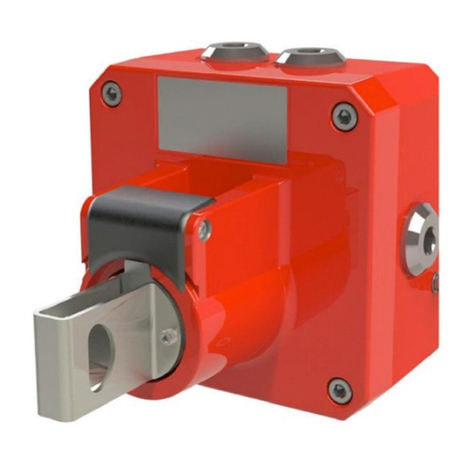
E2S
E2S GNExCP7-PB-S instruction manual
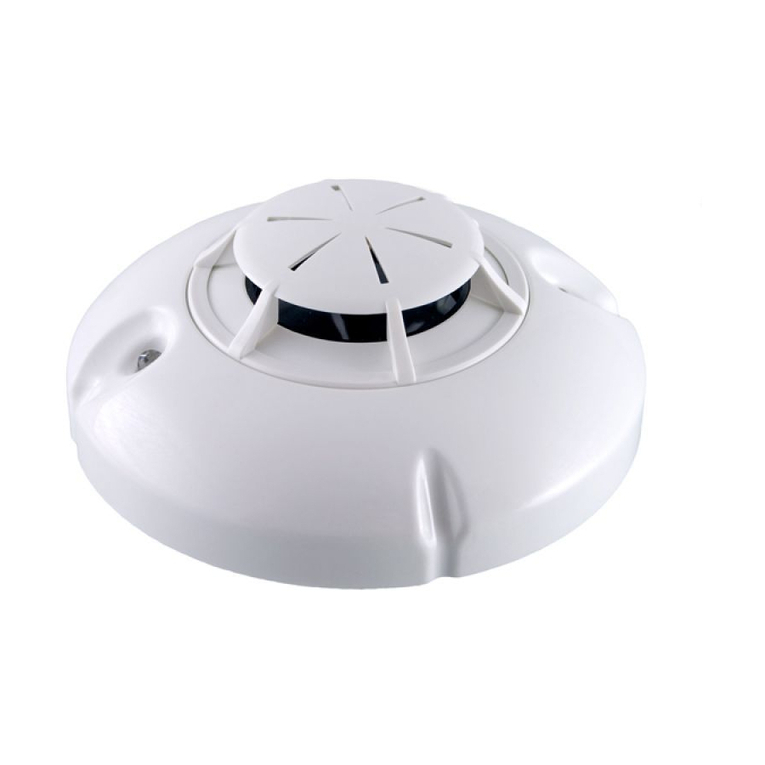
UniPOS
UniPOS FD7201 instruction manual

Tyco
Tyco F4000 Lcd operator's manual

thefirebeam
thefirebeam firebeam user guide
